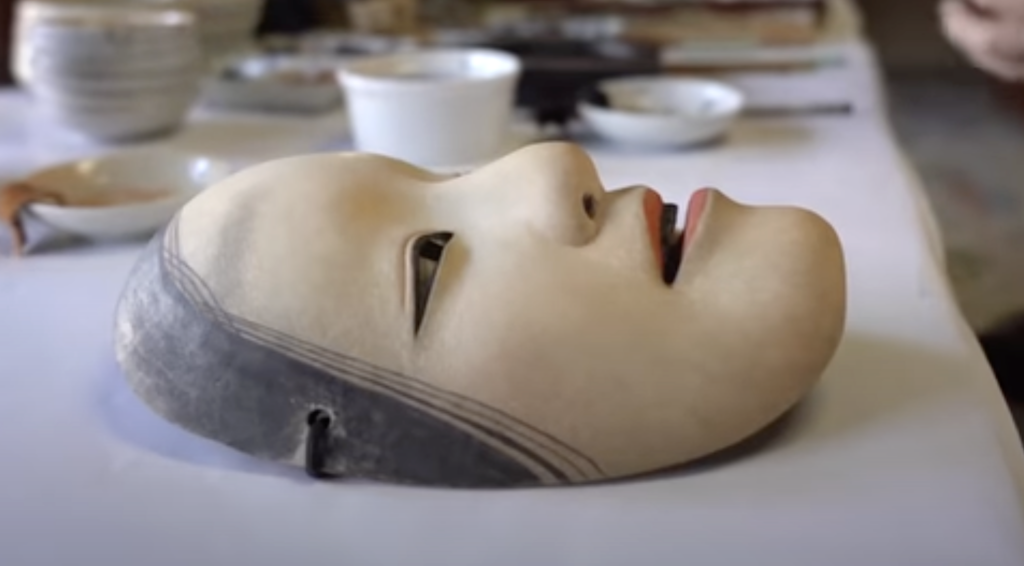Noh actors undergo years of rigorous training to perfect their performance technique.
The ancient classical art requires actors’ faces to be obscured by rigid masks carved from single blocks of hinoki wood. A thorough command of posture, physical gesture, and voice is essential for conveying the characters’ emotions.
The quality of the mask is of utmost importance, too.
Nakamura Mitsue, a maker of traditional Noh masks, whose interest in human faces and portraiture originally led her to study western art, notes that the creator must possess a high degree of skill if the mask is to function properly. The best masks will suggest different attitudes from different angles.
Terasu, or an upwards tilt conveys happy emotions, while the downward tilt of kumorasu expresses darker feelings and tears.
The most expertly carved masks’ eyes will appear to shift as the actor changes position.
The full range of human expression is the most difficult to achieve with delicate-featured female Noh masks.
“I used to change its direction and stare at it in the mirror all night,” Ms. Nakamura writes on her website, recalling how her mentor, the celebrated craftsman Yasuemon Hori, taught her how to carve Ko-Omote, a mask representing the youngest woman in the Noh canon.
When creating a mask of a beautiful girl or child I feel very happy but when creating an onryo (ghost spirit) I can feel sorrow or anger.
Ms. Nakamura’s dedication, expertise and patience are on abundant display in the wordless Process X video, above.
She is, as the New York Times notes, one of a growing number of female practitioners:
When she began, she knew of only one other woman in the field, but this year, all four of her current apprentices, some of whom study for as long as 10 years, are female. Some adhere to the traditional archetypes and techniques, while others radically reinterpret them.
Like many other Japanese women of her generation, she did as expected, marrying and having children shortly after completing her education. She began studying mask making when her children began school, waiting until they were 18 to leave her marriage. By then, she was well positioned to support herself as a professional nō-men-shi (Noh mask maker.)
A single mask by a respected nō-men-shi can take a month to complete, but can fetch a price in the neighborhood of ¥500,000.
Ms. Nakamura labors in a workshop in her traditional-style home in Kyoto.
Her tools and supplies are equally old-fashioned – a mixture of seashell powder and rice glue, a mortar and pestle, a chisel that she wields perilously close to her knees and slipper-clad feet…
As Jason Haidar writes in Kansai Scene:
It may be no coincidence that Ms. Nakamura wields a chisel so naturally and with such skill, One of the main chisels used for carving Noh masks is called a tou, which is another word meaning samurai sword. Ms. Nakamura always credited her parents for encouraging her to learn a skill that could allow her to support herself without a husband, and this modern thinking could be attributed to her family being of samurai lineage. After the reforms of the Meiji Restoration (1868-1912) that saw the ushering in of modern Japan, her ancestors learned the importance of being self-sufficient, independent, and having a diverse range of skills – values which were passed down to her.
Explore a gallery of Mitsue Nakamura’s Noh masks here. Click on specific images to learn about each mask’s purpose in Noh, recognized by UNESCO as having “Intangible Cultural Heritage”.
Related Content
A Hypnotic Look at How Japanese Samurai Swords Are Made
20 Mesmerizing Videos of Japanese Artisans Creating Traditional Handicrafts
– Ayun Halliday is the Chief Primatologist of the East Village Inky zine and author, most recently, of Creative, Not Famous: The Small Potato Manifesto and Creative, Not Famous Activity Book. Follow her @AyunHalliday.

